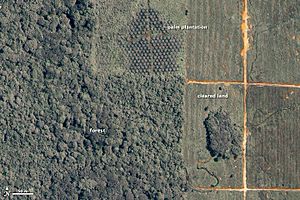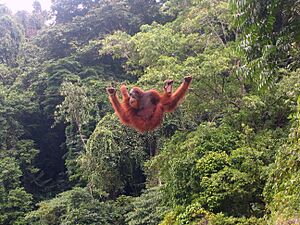Social and environmental impact of palm oil facts for kids
Palm oil comes from the oil palm tree. It's a very important crop for many farmers in places like Southeast Asia, Central and West Africa, and Central America. People use it for cooking, in many foods and personal care products, and even to make biofuel (fuel from plants). Oil palms make much more oil per area of land than other plants like soybeans or sunflowers.
Oil palms produce 38% of the world's plant-based oil. They do this on only 5% of the land used for such oils. But growing palm oil can cause problems for the environment. This includes losing forests that store carbon and have many different plants and animals. There are also worries about how palm oil farming affects human and animal populations.
Contents
Palm Oil Facts
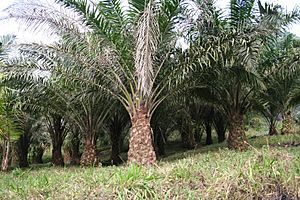
About 1.5 million small farmers in Indonesia grow palm oil. In Malaysia, around 500,000 people work directly in this industry. Many others work in related businesses.
By 2006, palm oil farms covered about 11 million hectares (42,000 square miles). The Malaysian Palm Oil Association manages about half a billion palm trees. These trees help store carbon. The demand for palm oil keeps growing.
Between 1967 and 2000, the land used for palm oil in Indonesia grew a lot. It went from less than 2,000 square kilometers (770 sq mi) to over 30,000 square kilometers (12,000 sq mi). Deforestation in Indonesia for palm oil and illegal logging was very fast. A 2007 report said most of Indonesia's forests could be gone by 2022. Luckily, the rate of forest loss has slowed down in recent years.
In 2010, the world made a record 46.9 million tonnes of palm oil. Indonesia produced most of this increase.
Forest Loss and Animals
How Palm Oil Farming Affects Habitats
Making palm oil often means cutting down many trees. This leads to a loss of plants and animals where the land is cleared. Tropical rainforests in countries like Malaysia and Indonesia are perfect for large palm oil farms. They have lots of rain and sunshine all year.
Between 1990 and 2005, the land used for palm oil in Malaysia grew by 2.4 million hectares. It reached 4.2 million hectares. During that time, over 1.1 million hectares of rainforest were lost. The many different plants and animals in these forests are disappearing fast. Animals are often sensitive and easily harmed by deforestation.
Wildlife has been most affected where large areas are cleared for palm oil. Animals are forced to move. They often come closer to humans as they look for food in nearby villages. Some animals cannot adapt and move, so their numbers drop a lot. This harms the natural balance in their homes.
When forests become farms, there are fewer types of plants and animals. This is especially true for old, untouched forests.
A big worry is the critically endangered Bornean orangutan. A study from 2018 showed that over 100,000 orangutans were lost between 1999 and 2015. This was partly due to the palm oil industry. Researchers tracked their nests. The number of nests dropped by more than half during this time.
Palm oil farming can also help invasive species spread. For example, the Anoplolepis gracilipes in Southeast Asia. Many types of animals suffer when forests are replaced by palm oil farms. This includes ants, bats, primates, bees, beetles, birds, dung beetles, isopods, lizards, mosquitoes, moths, and small mammals. Most of these animals also have fewer numbers. But some, like certain dung beetles and isopods, might increase in number while still losing different types of species. Bees are unusual; they lose numbers but gain different types of species in oil palm areas.
Soil Problems
Removing old plants and planting palm oil trees is bad for the soil. When plants are removed, the soil often washes away. Farmers use many fertilizers and pesticides to make palm oil trees grow fast and stay healthy. Young palm oil trees take a lot of nutrients from the soil. This makes the soil less healthy. As nutrients are used up, farmers add more fertilizers.
Palm oil trees are often planted very close together to use space well. This also harms soil quality. As trees grow, they need more minerals and water. Because they are so close, there isn't enough for all of them. So, farmers add even more fertilizers, pesticides, and water. This further damages the soil. It makes it hard for other plants and animals to live there.
In tropical countries like Malaysia and Indonesia, it rains a lot. Palm oil farms near rivers can cause more problems for local people. The extra fertilizers and pesticides are often washed into rivers by the rain. This is a problem because villagers use river water for drinking and food. This untreated water can cause serious health issues like cholera, E. coli, and lead poisoning.
Damage from soil erosion and poor soil quality also affects villagers' lives. They can no longer rely on their land for food and wood. They have to find new ways to get food and build homes. This sometimes forces them to move. Governments then need to help these communities.
Other Environmental Concerns
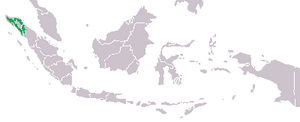
In Indonesia, the demand for palm oil and wood has led to clearing forests in national parks. A 2007 report said that if deforestation continued at that rate, 98% of Indonesian forests could be gone by 2022. This was due to legal and illegal logging, forest fires, and new palm oil farms.
Malaysia, the second largest palm oil producer, has promised to keep at least 50% of its land as forests. In 2010, 58% of Malaysia was forested.
Palm oil farming has been criticized for:
- Greenhouse gas emissions: Cutting down tropical forests causes about 10% of human-made CO{{subst:2}} emissions. This contributes to climate change.
- Habitat destruction: This leads to the loss of critically endangered species like the Sumatran elephant, Sumatran tiger, Sumatran rhinoceros, and Sumatran orangutan.
- Reduced biodiversity: This harms areas with many different types of life.
- Farming on land that belongs to indigenous people in Borneo and Sabah.
- An increase in diseases that spread from animals to humans. This is linked to forest loss in tropical countries.
Water Pollution
In some places where oil palm is grown, environmental rules are not strictly followed. This leads to farms spreading into areas near rivers. It also means waste like palm oil mill effluent (POME) is released into the environment. POME is a waste product from making palm oil. It can be hard and costly to get rid of. So, it's often dumped into nearby water.
POME has many nutrients. It can cause algae blooms to grow. These blooms use up oxygen in the water. This harms aquatic life and changes ecosystems.
More eco-friendly ways to handle POME have been found. One way is to treat it without oxygen. This can create biogas (methane) and electricity. But it's hard to keep the right conditions for the tiny organisms that break down the waste.
Greenhouse Gas Emissions
Damage to peatlands, partly from palm oil production, adds to environmental harm. This includes 4% of global greenhouse gas emissions. It's also 8% of all global emissions from burning fossil fuels each year. This is because large areas of rainforest are cleared for palm oil farms. Many Indonesian and Malaysian rainforests are on top of peat bogs. These bogs store huge amounts of carbon. When forests are removed and bogs are drained for farms, this carbon is released.
One study shows that changing peatlands into farms causes 16.6% to 27.9% of all greenhouse gas emissions from Malaysia and Indonesia. Draining peatlands and growing young palms creates 50% more greenhouse gas emissions than older farms. This is a growing worry as more tropical peatlands are turned into farms to meet the demand for palm oil.
Researchers are looking for greener solutions. They suggest that if enough land is saved as primary forest, the palm oil industry might not harm wildlife and biodiversity as much. Groups like Greenpeace and the Roundtable on Sustainable Palm Oil are also working to stop unsustainable palm oil farming.
Greenpeace says that cutting down peatlands creates more emissions than biofuels save. They point to Indonesian peatlands. These unique tropical forests have dense soil that releases carbon when burned. Greenpeace says destroying them for palm oil farms is a big problem. They claim this destruction already causes 4% of global CO{{subst:2}} emissions each year. However, some research suggests that oil palm farms can actually store carbon.
Greenpeace recorded peatland destruction in Riau, Sumatra. This area has 25% of Indonesia's palm oil farms. Greenpeace says this will badly affect Riau's peatlands, which store a massive 14.6 billion tonnes of carbon.
Some suggest that environmental groups should work with palm oil companies. They could buy small parts of existing farms. Then, they could use the profits to create private nature reserves. This might be better than fighting, which can hurt the lives of millions of small farmers.
Haze
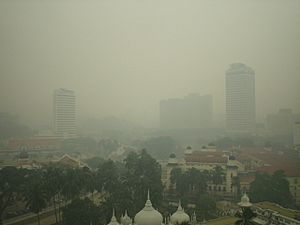
Haze, a type of air pollution, is a big problem in Southeast Asia. It's partly caused by burning rainforests and peat swamp forests to clear land for palm oil farms.
Differences Between Countries
Indonesia and Malaysia
Indonesia and Malaysia produce over 80% of the world's palm oil. In these countries, small farmers grow 35–40% of the oil palm. They also produce up to 33% of the total output. In West African countries, small farmers produce up to 90% of the harvest.
Malaysia has promised to keep at least 50% of its land as natural forest. So, new palm oil farms have grown slower there. Malaysian farmers are now trying to produce more oil without expanding their farms.
In 2008, Malaysia said it wanted a sustainable palm oil industry. Since then, the Malaysian government and palm oil companies have made more certified sustainable palm oil (CSPO). Malaysia is the largest producer of CSPO, making 50% of the world's supply. Indonesia produces 35% of the world's CSPO.
In Indonesia, the Indigenous Peoples' Alliance of the Archipelago (AMAN) works for fair policies. They want to balance economic needs with the rights of indigenous people. About 99% of palm oil farms in Indonesia are on land used by indigenous people. In 2012, AMAN helped win a court case that recognized their land rights. But it has been hard to fully protect these rights and the environment.
Africa
In Africa, the situation is different. A 2007-2008 report said that palm oil production in West Africa is mostly sustainable. This is because it's done by small farmers, not large farms that grow only one crop. The United Nations Food and Agriculture program encourages small farmers in Africa to grow palm oil. It helps them earn more money and improve their lives.
Growing Demand for Palm Oil
Food and cosmetics companies like ADM, Unilever, Cargill, and Nestlé need more palm oil. The demand grew partly because companies needed an oil with less trans fat.
Palm oil is used to make biodiesel. A 2012 report found that the increase in palm oil production is mostly due to food demands, not biofuel needs.
Biodiesel
Biodiesel made from palm oil grown on sustainable land (not forests) and existing farms can reduce greenhouse gas emissions. Greenpeace says that clearing peatland for oil palms releases many greenhouse gases. So, biodiesel from these farms might not actually reduce emissions. However, some research suggests that oil palm farms on peatland produce less carbon dioxide than forest peat swamps. But some say this research might be biased.
In 2011, eight of Malaysia's FELDA farms were certified for sustainable palm biodiesel. This means they follow rules for renewable energy in Europe. In 2012, the European Commission approved the RSPO's biofuel certification. This allows certified sustainable palm oil biofuel to be sold in Europe.
Sustainable Palm Oil
In 2016, about 17.4% of palm oil met voluntary sustainability standards. These include the Roundtable on Sustainable Palm Oil, Rainforest Alliance, and organic certifications.
The Roundtable on Sustainable Palm Oil (RSPO) was started in 2004. It works to promote sustainably sourced palm oil. Growers, food companies, and environmental groups are involved. Since 2008, palm oil that meets RSPO standards is called "certified sustainable palm oil" (CSPO). Within two years, CSPO made up 7% of the global palm oil market. By October 2012, 12% of palm oil was RSPO certified.
In 2010, The Economist criticized the RSPO. They said it didn't set rules for greenhouse gas emissions from farms. Also, its members only made 40% of the palm oil. In 2007, Greenpeace said that RSPO-member food companies used palm oil from suppliers who were cutting down forests.
In 2010, Indonesia paused new agreements to clear natural forests and peatlands for two years. This was after Norway gave $1 billion. Indonesia also planned its own government certification system for all its palm oil producers.
In 2011, Malaysia started its own "Malaysia sustainable palm oil" (MSPO) certification. This aims to improve sustainable palm oil production across the country. It's for small and medium-sized producers. Malaysia also studies the environmental impact of its oil palm industry.
In 2020, scientists used satellite images to show something important. They found that "sustainable" palm oil production still led to deforestation in Sumatra and Borneo. It also harmed endangered animals' homes over 30 years.
Carbon Credit Programs
Oil palm producers can join Clean Development Mechanism (CDM) programs. In these programs, richer countries invest in clean energy projects in developing countries. This helps them earn carbon credits. These credits help offset their own greenhouse gas emissions and reduce global emissions.
Some investors are careful about palm oil biofuel projects. This is because expanding oil palm farms has harmed tropical rainforests. But some companies say that many CDM projects in the palm oil sector focus on using waste products better. This helps reduce gas emissions and doesn't create new oil palm farms.
SPOTT: Checking Company Policies
Palm oil production has grown a lot since the late 1900s. It increased 15 times between 1980 and 2014. Besides Indonesia and Malaysia, countries in Latin America are also growing more palm oil.
SPOTT is a free online tool. It checks how well companies that produce or trade palm oil share information. This information is about their environmental, social, and governance (ESG) practices.
SPOTT looks at 100 palm oil companies. It checks their public information about ESG issues. Each company gets a score to show how they improve over time.
SPOTT uses detailed rules to score companies. These rules are based on best practices and relate to goals like the United Nations Sustainable Development Goals.
You can find more details about these scores here.
Sometimes, a company's promises might not be fully carried out. Checking the news about a company can help. But it's also important to see if their plans are actually happening on the ground.
Companies Using Sustainable Oil
The World Wildlife Foundation (WWF) publishes a yearly report. It shows how major companies use sustainable palm oil. In the 2011 report, 31 out of 132 companies got a top score. This was an improvement from 2009, when no companies got top scores.
The WWF reports that 87 companies promised to use only sustainable palm oil by 2015. This includes Unilever and Nestlé. They made these promises after environmental groups pushed them. However, the WWF says that the overall growth in using sustainable palm oil is too slow.
Retailers like Walmart and Carrefour have also promised to offer products with sustainable oil. They say that consumers don't show enough interest. This lack of demand worries them about the cost and future availability of sustainable palm oil.
Talking to Governments
It might be possible to convince governments in countries that produce other oils to make laws against products from deforestation. A report suggested this idea. It estimated that protecting 13 million hectares (50,000 sq mi) of tropical forest each year could boost American farming income by $190–270 billion between 2012 and 2030. However, some conservation groups disagreed. They said this idea was based on the wrong idea that stopping deforestation in tropical countries is easy.


